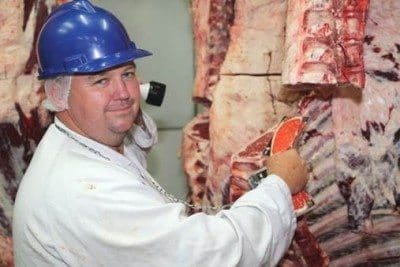TWELVE months after the launch of the industry’s new Eating Quality Graded trading language cipher, there has been surprisingly strong adoption in export and domestic beef markets.
About 27 percent of Meat Standards Australia graded beef is now being packed under the new EQG cipher. That product is coming through six separate MSA-licensed processors, some with multiple processing sites in both northern and southern regions of the country.
 The new EQG industry cipher (click here to view Beef Central’s article published at time of launch) is available as an option over traditional dentition (teeth-based) language ciphers used for the past three decades to trade Australian beef. The EQG cipher was developed as one of 46 recommendations in last year’s beef language review, and is the first to be fully commercialised.
The new EQG industry cipher (click here to view Beef Central’s article published at time of launch) is available as an option over traditional dentition (teeth-based) language ciphers used for the past three decades to trade Australian beef. The EQG cipher was developed as one of 46 recommendations in last year’s beef language review, and is the first to be fully commercialised.
It allows processors and brand owners to pack and sell product specifically on eating quality, as indicated by MSA grading index scores, rather than using other eating quality ‘proxies’ like dentition, to produce ciphers like *YG* and *PR*.
A commonly held belief at the time the new EQG cipher was launched last year was that it would take considerable time to gain momentum in export markets, where meat trading had taken place for decades on the basis of dentition. As reported at the time, getting customers to agree to trade on MSA index results, rather than teeth, was seen by some as a challenge.
Noting the strong uptake of the cipher while visiting Brisbane show last week, MLA general manager industry systems Michael Crowley said EQG cipher was allowing brand owners to better segregate on quality.
“We’re having a lot of conversations with brand owners about how they can now start to segregate on MSA eating quality into really neatly-tiered brands, and reduce variation within those brands,” Mr Crowley said.
“It has the potential to take complexity out of the system through less sorting lines – allowing managers to sort by brand outcome, that meets a customer need, and ultimately the end consumer.”
He said there was already evidence of premiums being paid on eating quality, rather than dentition.
One of the biggest benefits was in price differentials based on dentition categories, where animals displaying four or even six teeth could still have tremendous eating quality outcomes, based on MSA index scores. Previously, those MSA-eligible cattle were often discounted in the marketplace.
“If we just pack that product from those higher dentition cattle with good eating quality outcomes, it has been calculated that the opportunity to industry is worth close to $50 million a year,” Mr Crowley said.
“The feedback we are getting from participating processors is that the new cipher is making the conversation easier with the customer, because ultimately the customer is really wanting a consistent quality level that meets their needs,” Mr Crowley said.
“MSA is still the program that underpins the brands, it’s just that its delivered to the trade under EQG, rather than dentition. If you think about the sales conversation with the customer, it’s eating quality graded, and then then start thinking about their brand attributes, how those animals were raised, and other factors.”
“If anything, it has actually simplified the conversation with customers, and that’s the feedback we’re getting,” Mr Crowley said.
“It’s just a natural evolution of the industry – we’ve had 20 years of MSA grading to get to the volumes required to underpin brands, and to really get market penetration. And the EQG cipher is just part of that process, helping simplify the conversation.”
“The industry has had enough time to get enough data to make better decisions within their plant, and we’re also then seeing the price signals go back to producers – a really nice supply chain story that is adding value along the value chain.”
Education part of Teys experience
Teys Australia was one of the early adopters of the new EQG trading cipher, starting to sell beef from some of its MSA-backed grain and grassfed beef brands under eating quality outcomes in October. Another is HW Greenham & Sons, which is rolling-out the EQG cipher across its grassfed brands, and having particularly strong uptake in South Korea, the company told Beef Central.
Teys Australia has not found the transition to EQG to be as big an obstacle as some had anticipated.
“In short, we’ve had no push-back from the customer base, over moving away from dentition-based trading,” Teys value chain general manager Tom Maguire said.
Part of the process in moving away from dentition-based ciphers to eating quality-based outcomes was in educating the company’s meat sales team in what the new process was about.
“They are the ones having the conversations with the customers, both here and overseas,” Mr Maguire said.
“The learning for us has been that by investing in good education about the process, the supply chain will accept the EQA cipher. They clearly understand that it is delivering an eating quality outcome – which is actually what they care about. Nobody in a restaurant or making a purchase in a supermarket cares whether a steak came from a beast with two teeth or six teeth. It just has to eat well,” he said.
“It made no sense to segregate beef by different eating qualities using MSA indexes, and then try to do it all over again using teeth. The move to the EQA cipher has allowed us to simplify what we offer our customers, without compromising the eating performance in any way. It’s one of the smartest innovations that the industry has pushed through in a long time.”
“These days we’re selling brands to our customers – Riverine, Grasslands or 36 Degrees South, for example. It’s not about selling teeth, or MSA, but about getting the right eating quality guarantee that underpins those brands.
In certain markets, like the EU for example, Teys was still obliged to trade under dentition-based ciphers by law, but in most other markets, EQA was now the cipher of choice.

CQ cattle producer Ian McCamley
Central Queensland beef producer Ian McCamley has been a prominent critic of the traditional dentition-based trading systems that ignored those cattle with superior eating quality, but which carried more teeth.
“It’s great to see the EQG cipher gaining momentum in the market,” Mr McCamley said.
“It’s been a long time coming, but it’s nice to see that the market in fact has a level of knowledge and acceptance that has allowed this to happen more quickly than some might have expected.
“The science based approach has turned-up, and will outweigh the old methods of sorting cattle based on teeth.”
While good eating quality carcases from cattle with more teeth were now finding their way into branded beef programs, the price grids Mr McCamley was seeing for cattle were still based on dentition, however.
“Currently, producers are still being paid on dentition, while some processors are selling the beef using an EQG cipher. So we, as a broader industry, are not quite there yet. But eventually, as the new cipher’s share of overall beef trade grows, it will have to change.”
“Let’s just hope that any new international markets that MLA and others are opening up are educated about the use of the EQG cipher from the start, and are not getting confused by the old dentition-based ciphers.”
- Michael Crowley, Tom Maguire and Ian McCamley are all speaking during a Meat Standards Australia forum being held as part of a meat science congress in Melbourne later today. The International Congress of Meat Science & Technology is the world’s largest gathering of meat scientists, with close to 500 delegates attending from across the world. More reports on Beef Central later this week.

Agree with David. If this EQG cipher is influencing prices downstream of the supply chain, then we should expect this to be reflective in the way producers are paid upstream. As a producer, I’m interested to see how the removal of dentition as a grading parameter and the introduction of this EQG will influence the way processors will now structure their price grids.
Teys’ recent move to publicise prices is no doubt a good one, but it is disappointing that they don’t include their MSA pricing (which will probably be most changed by this EQG grading). Fingers crossed that when NH and JBS start putting their grids online, they include their MSA pricing. If all this MSA grading is in the light, this should allow the industry to come to a consensus to standardise this new EQG grading.
Great info Deborah……….thank you.
It is interesting in these so-called outcome focussed times that the past paradigms are still holding back a whole of supply chain approach to the price received at each point in the chain, the often mentioned ‘value based marketing’. It would be interesting to get MLA to do the numbers on what the total lost opportunity cost to the industry continues to be for a whole range of things other than dentition. This industry is at a crossroads at present, there are a lot of risks as well as opportunity. Producers are often critised for not adopting the latest information and technology to make improvements, this often takes a level of investment not previously undertaken, who with any long term history in this industry would make that investment without a healthy dose of scepticism? MSA undoubtedly continues to deliver outcomes that would even interest the most ardent sceptic I would imagine, but whilst the old paradigms such as meat colour and dentition influence returns you cannot expect people to fully commit. Deborah makes some interesting points, I would like to add that one of MSA’s competitors for top spot as the globally accepted benchmark for quality grading, the USDA system, had maturity score(which ossification is a component) and a ‘value based marketing’ system almost 100 years ago. History tells me that we have some catching up to do.
David Hill
Northern Independent Director
Cattle Council of Australia.
In 1997, 1998, 1999, 2000 and 2001 4-6 teeth cattle were always amongst the medal winners at Paddocks to Palates in its first iteration. The problem with young cattle ( milk teeth to 2 tooth) is that too many of them manifest vealer eating qualities – especially as the increasingly large skeletal frames delay the transition of veal to young adult cattle ( with bone frame complete). Veal beef will retain a stretchy resilience in its texture to allow for growing bones. That resilience is why we have to beat veal leg steaks to make them chewable. One of the other early claims of MSA was that cattle needed to be on a constant or rising plane of nutrition or they would display tough beef. Then there was the discovery of ‘compensatory’ tenderness which allowed the natural world of grazing animals to do what it has always done – compensate the bad times with the good.